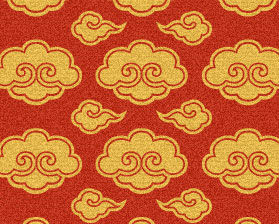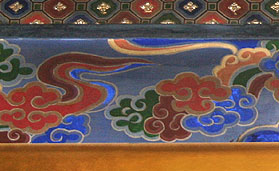| Lit. cloud design. A broad classification of the
various designs used to represent clouds. It is known throughout Asia, and after
water designs forms the most frequently employed design. It entered Japan through
China in the Nara period, when the design was characterized by long trailing tails,
known as the tenpyoumon V½Ά. It was often combined with designs of good
fortune *kisshoumon gΛΆ,
such as the phoenix *houou
P, *kirin κiΩ, or dragon *ryuu
΄. In the Heian period many types pf unmon belonging to the category of
ancient court designs known as *yuusoku
mon'you LEΆl were developed, including; boiling clouds
kumotatewaku _§N, moving clouds unkyorai _, and auspicious
cloudszuiun _, rain clouds amegumo J_, and ascending
clouds noborigumo γ_. From the middle ages the misumon δϊΆ
was used in the applied arts and picture scrolls *emaki
Gͺ to obscure portions of a depicted landscape or building, thus lending the scene
a distinct atmosphere. Later, more complicated reishiun μΕ_ were introduced
to Japan as Chinese textiles. In the Edo period , pictures or patterns were sometimes
divided into cloud-shaped areas arranged upon a larger picture. This practice
was known as kumotori _ζ or kasumitori ΰζ and was used especially
for dyed fabrics. |




